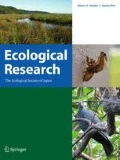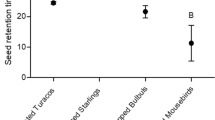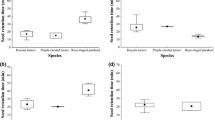Abstract
Many field studies on plant seed dispersal teach us that we cannot judge the effective dispersal mode of plants by examining only the morphologies of the fruits and seeds. In the present study, we explored the seed dispersal process of an evergreen tree, the Japanese star anise Illicium anisatum, which is highly toxic, containing neurotoxins in both the fruits and seeds. The fruits exhibit ballochory, a mode of seed dispersal characterized by explosive fruit dehiscence, and the extreme toxicity apparently seems to deter fruit and seed consumption by animals. However, we found that the dispersal distance afforded by this mode was very short (≤ 6 m). In the field, we confirmed that a passerine species, the varied tit Poecile varius, was the only consumer of the seed in foliage, and the bird actively transported seeds or fruits to either cache or consume them. Seeds setting on the forest understory were removed by the small Japanese field mouse Apodemus argenteus, and were also dispersed by this animal. Analysis of seedling spatial distribution revealed that seedlings were highly aggregated near standing trees or fallen logs, suggesting that caching facilitated seed dispersal. This study warns that plant toxicity and the ecological function thereof should not be evaluated based only on limited knowledge of the effects on humans and mammals. Our results pose further questions on the evolution of toxin tolerance in seed-caching animals and on the mutualism between toxic plants and animals.






Similar content being viewed by others
References
Abe H, Matsuki R, Ueno S, Nashimoto M, Hasegawa M (2006) Dispersal of Camellia japonica seeds by Apodemus speciosus revealed by maternity analysis of plants and behavioral observation of animal vectors. Ecol Res 21:732–740. https://doi.org/10.1007/s11284-006-0179-5
Aiba S-I, Kohyama T (1997) Crown architecture and life-history traits of 14 tree species in a warm-temperate rain forest: significance of spatial heterogeneity. J Ecol 85:611–624. https://doi.org/10.2307/2960532
Beck MJ, Vander Wall SB (2010) Diplochory in western chokecherry: you can’t judge a fruit by its mesocarp. Oecologia 165:131–141. https://doi.org/10.1007/s00442-010-1759-1
Briggs JS, Wall SBV, Jenkins SH (2009) Forest rodents provide directed dispersal of Jeffrey pine seeds. Ecology 90:675–687
Dearing MD, Foley WJ, McLean S (2005) The influence of plant secondary metabolites on the nutritional ecology of herbivorous terrestrial vertebrates. Annu Rev Ecol Evol Syst 36:169–189
Ehrlén J, Eriksson O (1993) Toxicity in fleshy fruits: a non-adaptive trait? Oikos 66:107–113
Fujita K (1996) Habitat characteristics of food storage sites of Varied Tits Parus varius. Strix 14:41–54 (in Japanese with English abstract)
Hashimoto H, Kamijyo T, Higuchi H (2002) Seed dispersal of Styrax japonica by Varied Tits Parus varius on Miyake-jima, Izu Islands. Jpn J Ornithol 51:101–107 (in Japanese with English abstract)
Higgins SI, Nathan R, Cain ML (2003) Are long-distance dispersal events in plants usually caused by nonstandard means of dispersal? Ecology 84:1945–1956
Higuchi H (1975) Comparative feeding ecology of two geographical formas of the Varied Tit, Parus vaius vaius in southern Izu peninsula and P. v. owstoni in Miyake I. of the Izu Is. Tori 24:15–28 (in Japanese with English abstract)
Higuchi H (1976) Ecological significance of the larger body sizes in an island subspecies of the varied tit Parus varius. Proc Jpn Soc Syst Zool 12:78–86
Hirano A, Sakuratani Y (2013) The relationship between Styrax japonica and Parus varius on the Nara Campus of Kinki University. Mem Fac Agric Kinki Univ 46:101–132 (in Japanese with English abstract)
Ide Y, Wong BY-L, Sashimura N (2013) The status of forest in the Amagi Mountains in 1811 recorded in a historical document. Bull Tokyo Univ For 128:87–120 (in Japanese with English abstract)
Iida S (1996) Quantitative analysis of acorn transportation by rodents using magnetic locator. Vegetatio 124:39–43. https://doi.org/10.1007/BF00045142
Iwabe Y (1991) Poisoning by Japanese star anise seeds. Food Hyg Saf Sci (Shokuhin Eiseigaku Zasshi) 32:472–474. https://doi.org/10.3358/shokueishi.32.472 (in Japanese)
Iwatsuki K, Boufford DE, Ohba H (2006) Flora of Japan, vol 2a. Kodansha, Tokyo
Kiyosu Y (1966) Encyclopedia of wild birds in Japan. Tokyodo, Tokyo (in Japanese)
Kobayashi H, Kubota Y, Yamada H, Yasumoto T, Okita M, Hirata H, Kanamori H, Toyota A (2003) Illicium religiosum poisoning in Japanese black cattle. J Jpn Vet Med Assoc 56:15–20. https://doi.org/10.12935/jvma1951.56.15 (in Japanese with English abstract)
Kudo Y, Oka J-I, Yamada K (1981) Anisatin, a potent GABA antagonist, isolated from Illicium anisatum. Neurosci Lett 25:83–88. https://doi.org/10.1016/0304-3940(81)90105-1
Lane JF, Koch WT, Leeds NS, Gorin G (1952) On the toxin of Illicium anisatum. I. The isolation and characterization of a convulsant principle: anisatin. J Am Chem Soc 74:3211–3215. https://doi.org/10.1021/ja01133a002
Levin SA, Muller-Landau HC, Nathan R, Chave J (2003) The ecology and evolution of seed dispersal: a theoretical perspective. Annu Rev Ecol Evol Syst 34:575–604
Marsh KJ, Wallis IR, Andrew RL, Foley WJ (2006) The detoxification limitation hypothesis: where did it come from and where is it going? J Chem Ecol 32:1247–1266. https://doi.org/10.1007/s10886-006-9082-3
Matsui T, Iida S, Kawahara T, Namikawa K, Hirakawa H (2010) Estimation of home range for Varied Tits (Parus varius) in late autumn near the northern range boundary of Siebold’s beech (Fagus crenata) in the scope of estimating dispersal distance of beech seeds. J Jpn For Soc 92:162–166. https://doi.org/10.4005/jjfs.92.162 (in Japanese with English abstract)
McLean S, Duncan AJ (2006) Pharmacological perspectives on the detoxification of plant secondary metabolites: implications for ingestive behavior of herbivores. J Chem Ecol 32:1213–1228
Miyaki M, Kikuzawa K (1988) Dispersal of Quercus mongolica acorns in a broadleaved deciduous forest 2. Scatterhoarding by mice. For Ecol Manag 25:9–16
Murakami T, Hayashida M, Ogiyama K (2006) Effect of seed caching by Parus varius on germination in Styrax japonica. J Jpn For Soc 88:174–180. https://doi.org/10.4005/jjfs.88.174 (in Japanese with English abstract)
Nakazawa Y, Takenaka F, Sakai K, Matsunaga Y, Oka T, Sadamatsu S, Kono S (1959) On the isolation of an active principle from Illicium anisatum L., its content and toxicity. Folia Pharmacol Jpn 55:524–530. https://doi.org/10.1254/fpj.55.524 (in Japanese)
Nathan R, Schurr FM, Spiegel O, Steinitz O, Trakhtenbrot A, Tsoar A (2008) Mechanisms of long-distance seed dispersal. Trends Ecol Evol 23:638–647. https://doi.org/10.1016/j.tree.2008.08.003
Oka T (1992) Home range and mating system of two sympatric field mouse species, Apodemus speciosus and Apodemus argenteus. Ecol Res 7:163–169. https://doi.org/10.1007/BF02348495
Pearson KM, Theimer TC (2004) Seed-caching responses to substrate and rock cover by two Peromyscus species: implications for pinyon pine establishment. Oecologia 141:76–83
Perea R, San Miguel A, Gil L (2011) Acorn dispersal by rodents: the importance of re-dispersal and distance to shelter. Basic Appl Ecol 12:432–439
Ridley HN (1930) The dispersal of plants throughout the world. L. Reeve, Ashford
Roberts ML, Haynes RR (1983) Ballistic seed dispersal in Illicium (Illiciaceae). Plant Syst Evol 143:227–232. https://doi.org/10.1007/BF00986380
Romanov MS, Bobrov AVFC, Endress PK (2013) Structure of the unusual explosive fruits of the early diverging angiosperm Illicium (Schisandraceae s.l., Austrobaileyales). Bot J Linn Soc 171:640–654. https://doi.org/10.1111/boj.12003
Sakakibara S (1989) The role of the varied tit, Parus varius T. and S., in the seed dispersal of Japanese yew, Taxus cuspidata S. and Z. J Jpn For Soc 71:41–49 (in Japanese with English abstract)
Sakes A, van der Wiel M, Henselmans PWJ, van Leeuwen JL, Dodou D, Breedveld P (2016) Shooting mechanisms in nature: a systematic review. PLOS ONE 11:e0158277. https://doi.org/10.1371/journal.pone.0158277
Seidler TG, Plotkin JB (2006) Seed dispersal and spatial pattern in tropical trees. PLoS Biol 4:e344. https://doi.org/10.1371/journal.pbio.0040344
Seiwa K, Watanabe A, Irie K, Kanno H, Saitoh T, Akasaka S (2002) Impact of site-induced mouse caching and transport behaviour on regeneration in Castanea crenata. J Veg Sci 13:517–526
Sherry F (1989) Food storing in the Paridae. Wilson Bull 101:289–304
Shimada T (2001) Hoarding behaviors of two wood mouse species: different preference for acorns of two Fagaceae species. Ecol Res 16:127–133. https://doi.org/10.1046/j.1440-1703.2001.00378.x
Shimada T, Saitoh T, Sasaki E, Nishitani Y, Osawa R (2006) Role of tannin-binding salivary proteins and tannase-producing bacteria in the acclimation of the Japanese wood mouse to acorn tannins. J Chem Ecol 32:1165–1180
Struempf HM, Schondube JE, Del Rio CM (1999) The cyanogenic glycoside amygdalin does not deter consumption of ripe fruit by cedar waxwings. Auk 116:749–758
Suganuma Y, Ishihara K (1953) Poisoning by Japanese star anise in sheep. J Jpn Vet Med Assoc 6:410–411 (in Japanese)
van der Pijl L (1982) Principles of dispersal in higher plants. Springer, Berlin
Vander Wall SB (1991) Mechanisms of cache recovery by yellow pine chipmunks. Anim Behav 41:851–863. https://doi.org/10.1016/S0003-3472(05)80352-5
Vander Wall SB, Longland WS (2004) Diplochory: are two seed dispersers better than one? Trends Ecol Evol 19:155–161
Vittoz P, Engler R (2007) Seed dispersal distances: a typology based on dispersal modes and plant traits. Bot Helvetica 117:109–124
Wang BC, Smith TB (2002) Closing the seed dispersal loop. Trends Ecol Evol 17:379–386
Wenny DG (2001) Advantages of seed dispersal: a re-evaluation of directed dispersal. Evol Ecol Res 3:37–50
Willson MF (1993) Dispersal mode, seed shadows, and colonization patterns. Vegetatio 107:261–280
Yoshikawa T, Isagi Y, Kikuzawa K (2009) Relationships between bird-dispersed plants and avian fruit consumers with different feeding strategies in Japan. Ecol Res 24:1301–1311. https://doi.org/10.1007/s11284-009-0612-7
Yui M (1988) Mori ni sumu yacho no seitaigaku (Ecology of wild birds in forests). Sobun, Tokyo (in Japanese)
Acknowledgements
We are grateful to Yuji Suda, the members of the Animal Ecology Laboratory at Rikkyo University, and those of the Community Dynamic Laboratory of the Forestry and Forest Products Research Institute for their assistance and constructive comments on our study. We thank Naoko Sashimura for informing us of the study site, Kaoru Niiyama for his help in identifying tree seedlings, and Shoji Naoe for allowing us to use his monitoring devices. We thank James Worth for checking English writing. We are grateful to the Izu Forest Management Office of the Forest Agency of Japan for permission to work in a national forest. During the study, the first author was partly supported by a Research Fellowship from the Japan Society for the Promotion of Science for Young Scientists (http://www.jsps.go.jp/english; Grant number 2610007) and the second author was supported funding by JSPS KAKENHI (Grant number JP17H00797).
Author information
Authors and Affiliations
Corresponding author
Electronic supplementary material
Below is the link to the electronic supplementary material.
ESM 1 Footage of a varied tit Poecile varius handling the fruit of the Japanese star anise Illicium anisatum and then transporting a seed and a fruit. (MP4 24321 kb)
About this article
Cite this article
Yoshikawa, T., Masaki, T., Motooka, M. et al. Highly toxic seeds of the Japanese star anise Illicium anisatum are dispersed by a seed-caching bird and a rodent. Ecol Res 33, 495–504 (2018). https://doi.org/10.1007/s11284-018-1564-6
Received:
Accepted:
Published:
Issue Date:
DOI: https://doi.org/10.1007/s11284-018-1564-6




